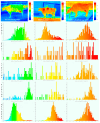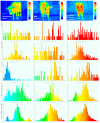Influence of Heat Stress on Body Surface Temperature and Blood Metabolic, Endocrine, and Inflammatory Parameters and Their Correlation in Cows
- PMID: 38392996
- PMCID: PMC10890091
- DOI: 10.3390/metabo14020104
Influence of Heat Stress on Body Surface Temperature and Blood Metabolic, Endocrine, and Inflammatory Parameters and Their Correlation in Cows
Abstract
This study aimed to determine whether heat stress affected the values and correlations of metabolic, endocrinological, and inflammatory parameters as well as the rectal and body surface temperature of cows in the early and middle stages of lactation. This experiment was conducted in May (thermoneutral period), June (mild heat stress), and July (moderate to severe heat stress). In each period we included 15 cows in early lactation and 15 in mid-lactation. The increase in rectal and body surface temperatures (°C) in moderate to severe heat stress compared to the thermoneutral period in different regions was significant (p < 0.01) and the results are presented as mean and [95%CI]: rectal + 0.9 [0.81-1.02], eye + 6 [5.74-6.25], ear + 13 [11.9-14.0], nose + 3.5 [3.22-3.71], forehead + 6.6 [6.43-6.75], whole head + 7.5 [7.36-7.68], abdomen + 8.5 [8.25-8.77], udder + 7.5 [7.38-7.65], front limb + 6 [5.89-6.12], hind limb + 3.6 [3.46-3.72], and whole body + 9 [8.80-9.21]. During heat stress (in both mild and moderate to severe stress compared to a thermoneutral period), an increase in the values of extracellular heat shock protein 70 (eHsp70), tumor necrosis factor α (TNFα), cortisol (CORT), insulin (INS), revised quantitative insulin sensitivity check index (RQUICKI), urea, creatinine, total bilirubin, aspartate transpaminase (AST), gamma-glutamyl transferase (GGT), lactate dehydrogenase (LDH), and creatin kinase (CK) occurred, as well as a decrease in the values of triiodothyronine (T3), thyroxine (T4), non-esterified fatty acids (NEFA), glucose (GLU), β-Hydroxybutyrate (BHB), calcium, phosphorus, total protein (TPROT), albumin (ALB), triglycerides (TGCs), and cholesterol (CHOL). In cows in early lactation compared to cows in mid-lactation, there was a significantly larger increase (p < 0.01) in the values of eHsp70, TNFα, GLU, RQUICKI, and GGT, while the INS increase was smaller during the three experimental periods. The decrease in the values of Ca, CHOL, and TGC was more pronounced in cows in early lactation compared to cows in mid-lactation during the three experimental periods. Rectal temperature was related to eHsp70 (r = 0.38, p < 0.001) and TNFα (r = 0.36, p < 0.01) and showed non-significant poor correlations with other blood parameters. Blood parameters correlate with body surface temperature, with the following most common results: eHsp70 and TNFα showed a moderately to strongly significant positive correlation (r = 0.79-0.96, p < 0.001); CORT, INS, and Creat showed fairly to moderately significant positive correlations; T3, T4, NEFA and GLU showed fairly to moderately significant negative correlations (r = 0.3-0.79; p < 0.01); RQUICKI, urea, AST, and GGT showed fairly and significantly positive correlations; and TGC, CHOL, TPROT, and ALB showed fairly and significantly negative correlations (r = 0.3-0.59; p < 0.01). Measuring the surface temperature of the whole body or head can be a useful tool in evaluating the metabolic response of cows because it has demonstrated an association with inflammation (TNFα, eHsp70), endocrine response (CORT, T3, T4), the increased use of glucose and decreased use of lipids for energy purposes (INS, NEFA, GLU, and RQUICKI), and protein catabolism (ALB, TPROT, urea, Creat), which underlies thermolysis and thermogenesis in cows under heat stress. In future research, it is necessary to examine the causality between body surface area and metabolic parameters.
Keywords: correlation; cow; heat stress; infrared thermography; metabolic adaptation.
Conflict of interest statement
The authors declare no conflicts of interest.
Figures



References
-
- Cincović M.R., Majkić M., Belić B., Plavša N., Lakić I., Radinović M. Thermal comfort of cows and temperature humidity index in period of 2005–2016 in Vojvodina region (Serbia) Acta Agric. Serbica. 2017;22:133–145. doi: 10.5937/AASer1744133C. - DOI
-
- Pecelj M.M., Lukić M.Z., Filipović D.J., Protić B.M., Bogdanović U.M. Analysis of the Universal Thermal Climate Index during heat waves in Serbia. Nat. Hazards Earth Syst. Sci. 2020;20:2021–2036. doi: 10.5194/nhess-20-2021-2020. - DOI
-
- Vranić P., Milutinović S. From local sustainable development towards climate change adaptation: A case study of Serbia. Int. J. Sustain. Dev. World Ecol. 2016;23:71–82. doi: 10.1080/13504509.2015.1070381. - DOI
Grants and funding
LinkOut - more resources
Full Text Sources
Research Materials
Miscellaneous

